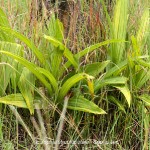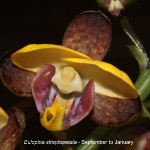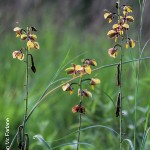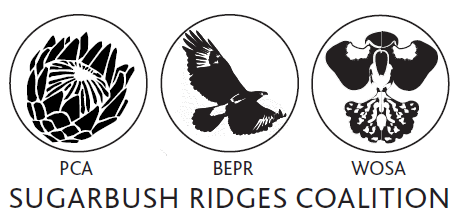Eulophia streptopetala
Description
Robust terrestrial with flowering stems that can grow up to 2.5m tall. The pseudobulb grows partially above the ground (much like a Cymbidium) and is up to 40 mm in diameter. The new growths develop from the base of the previous seasons matured pseudobulbs and the leaves are partially to fully developed when flowering. Leaves number between 4 and 9 and have a distinct ribbing appearance. The inflorescences, which grow next to the new growth with the developing pseudobulb, carries between 10 and 40 flowers. These are borne sequentially. Sepals are olive-green to green and are suffused with a reddish-brown. The petals are a chrome-yellow colour. No fragrance has been detected. The spur is 2mm in length.
Distribution in South Africa
Widespread in all provinces, except the Western Cape and Northern Cape. Not endemic.
Please submit your orchid photographs to OrchidMAP as citizen science records to improve this map.
Register on the Virtual Museum or login.
Typical habitat
It is always grows in shady areas under trees. At higher altitudes it has adapted to alien timber plantations and is only one of a few indigenous orchids that grows in the acidic conditions under Pine trees and in Eucalyptus plantations. It starts growing around September and reaches it's flowering peak in November.
Flowering Period
This species typically flowers between December and January / February.
Distribution elsewhere in Africa
It is also found north of South Africa in Namibia, Zimbabwe, Mocambique, Malawi, Tanzania, Kenya, Zambia and Ethiopia.
Conservation Status
This species is known from many localities over an extensive distribution range.
All orchids are protected under CITES regulations.
References and additional information
Johnson, S.D., Bytebier, B., Stärker, H. (2010). Orchids of South Africa: A field guide. Struik Nature, Cape Town, South Africa.
La Croix, I.F., la Croix, E. (1997). African Orchids in the Wild and in Cultivation. Timber Press, Portland, Oregon, USA.
This genus and species article was written by Duncan Mc Farlane and published 2019-04-12
Images





